用Python研究了三千套房子,告訴你究竟是什么抬高了房價?
關于房價,一直都是全民熱議的話題,畢竟不少人終其一生都在為之奮斗。
房地產的泡沫究竟有多大不得而知?今天我們拋開泡沫,回歸房屋最本質的內容,來分析一下房價的影響因素究竟是什么?
1、導入數據
- import numpy as np
- import pandas as pd
- import matplotlib.pyplot as plt
- import seaborn as sn
- import missingno as msno
- %matplotlib inline
- train = pd.read_csv('train.csv',index_col=0)
- #導入訓練集
- test = pd.read_csv('test.csv',index_col=0)
- #導入測試集
- train.head(3)
- print('train訓練集缺失數據分布圖')
- msno.matrix(train)
- print('test測試集缺失數據分布圖')
- msno.matrix(test)

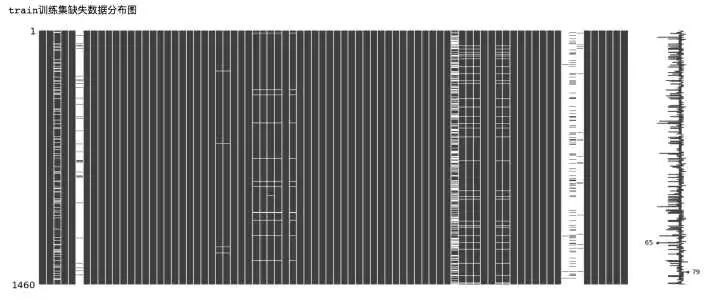
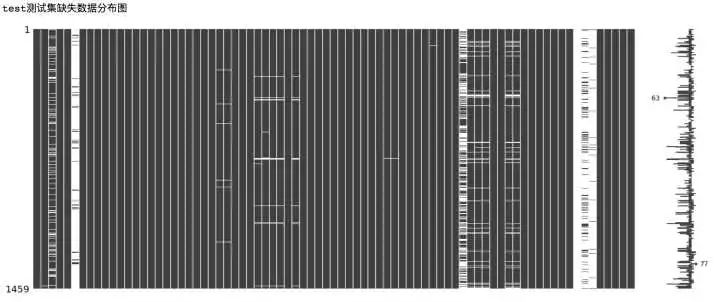
從上面的數據缺失可視化圖中可以看出,部分特征的數據缺失十分嚴重,下面我們來對特征的缺失數量進行統計。
2、目標Y值分析
- ##分割Y和X數據
- y=train['SalePrice']
- #看一下y的值分布
- prices = pd.DataFrame({'price':y,'log(price+1)':np.log1p(y)})
- prices.hist()
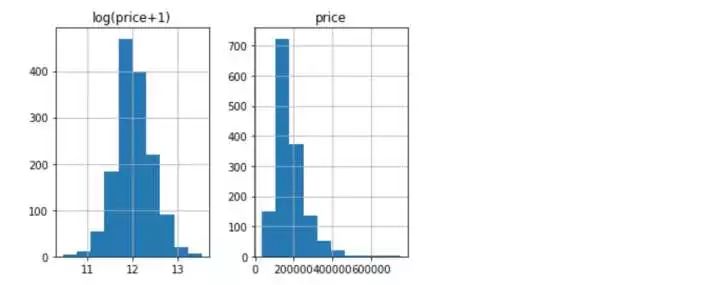
觀察目標變量y的分布和取對數后的分布看,取完對數后更傾向于符合正太分布,故我們對y進行對數轉化。
- y = np.log1p(y) #+1的目的是防止對數轉化后的值無意義
3、合并數據 缺失處理
- #合并訓練特征和測試集
- all_df = pd.concat((X,test),axis=0)
- print('all_df缺失數據圖')
- msno.matrix(all_df)
- #定義缺失統計函數
- def show_missing(feature):
- missing = feature.columns[feature.isnull().any()].tolist()
- return missing
- print('缺失特征的數據缺失量統計:')
- all_df[show_missing(all_df)].isnull().sum()
- #先處理numeric數值型數據
- #挨個兒看一下分布
- fig,axs = plt.subplots(3,2,figsize=(16,9))
- all_df['BsmtFinSF1'].hist(ax = axs[0,0])#眾數填充
- all_df['BsmtFinSF2'].hist(ax = axs[0,1])#眾數
- all_df['BsmtUnfSF'].hist(ax = axs[1,0])#中位數
- all_df['TotalBsmtSF'].hist(ax = axs[1,1])#均值填充
- all_df['BsmtFullBath'].hist(ax = axs[2,0])#眾數
- all_df['BsmtHalfBath'].hist(ax = axs[2,1])#眾數
- #lotfrontage用均值填充
- mean_lotfrontage = all_df.LotFrontage.mean()
- all_df.LotFrontage.hist()
- print('用均值填充:')
- cat_input(all_df,'LotFrontage',mean_lotfrontage)
- cat_input(all_df,'BsmtFinSF1',0.0)
- cat_input(all_df,'BsmtFinSF2',0.0)
- cat_input(all_df,'BsmtFullBath',0.0)
- cat_input(all_df,'BsmtHalfBath',0.0)
- cat_input(all_df,'BsmtUnfSF',467.00)
- cat_input(all_df,'TotalBsmtSF',1051.78)
- #在處理字符型,同樣,挨個看下分布
- fig,axs = plt.subplots(4,2,figsize=(16,9))
- all_df['MSZoning'].hist(ax = axs[0,0])#眾數填充
- all_df['Utilities'].hist(ax = axs[0,1])#眾數
- all_df['Exterior1st'].hist(ax = axs[1,0])#眾數
- all_df['Exterior2nd'].hist(ax = axs[1,1])#眾數填充
- all_df['KitchenQual'].hist(ax = axs[2,0])#眾數
- all_df['Functional'].hist(ax = axs[2,1])#眾數
- all_df['SaleType'].hist(ax = axs[3,0])#眾數
- cat_input(all_df,'MSZoning','RL')
- cat_input(all_df,'Utilities','AllPub')
- cat_input(all_df,'Exterior1st','VinylSd')
- cat_input(all_df,'Exterior2nd','VinylSd')
- cat_input(all_df,'KitchenQual','TA')
- cat_input(all_df,'Functional','Typ')
- cat_input(all_df,'SaleType','WD')
- #再看一下缺失分布
- msno.matrix(all_df)
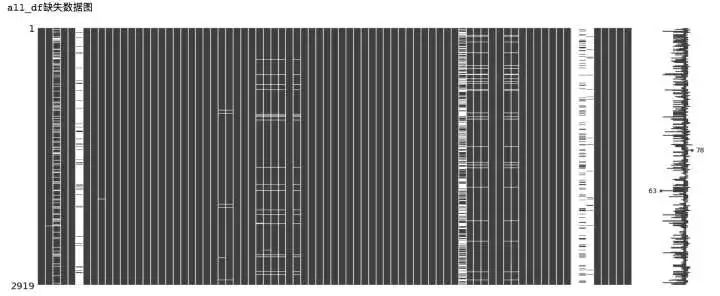
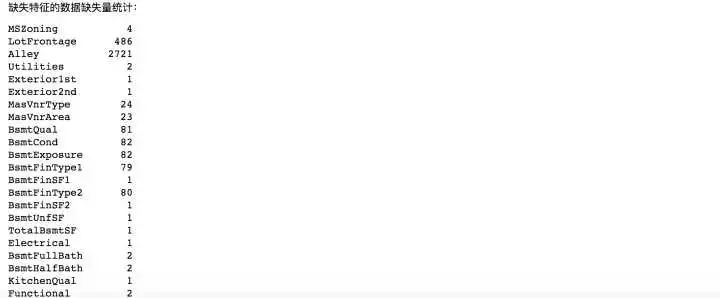
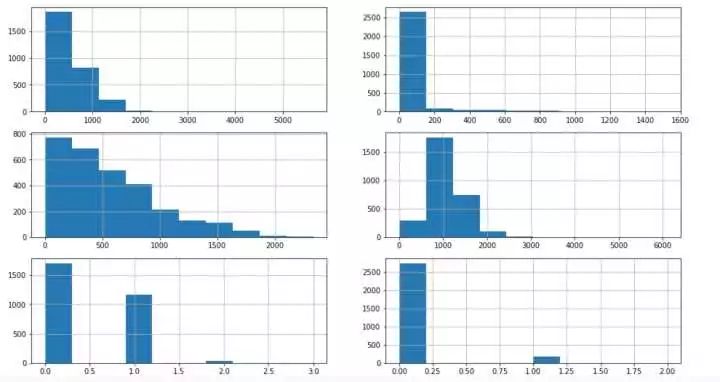
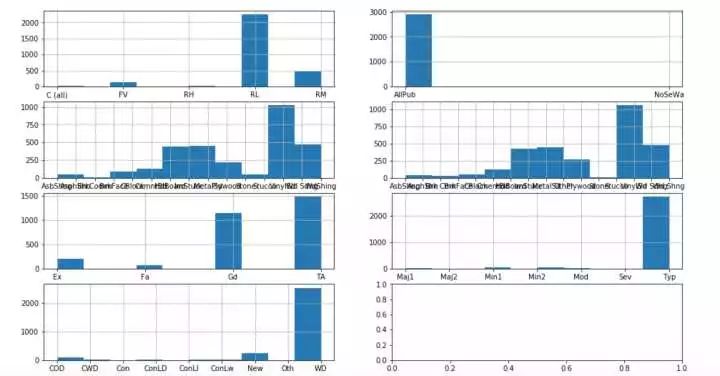
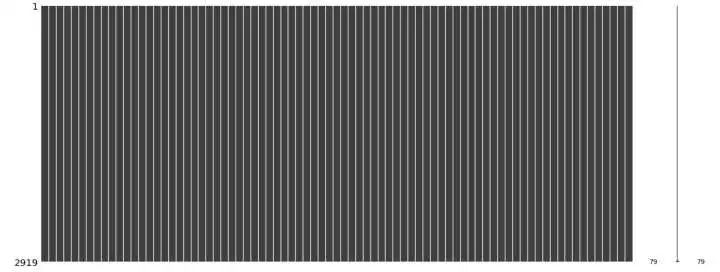
binggo,數據干凈啦!下面開始處理特征,經過上述略微復雜的處理,數據集中所有的缺失數據都已處理完畢,可以開始接下來的工作啦!
缺失處理總結:在本篇文章所使用的數據集中存在比較多的缺失,缺失數據包括數值型和字符型,處理原則主要有兩個:
一、根據繪制數據分布直方圖,觀察數據分布的狀態,采取合適的方式填充缺失數據;
二、非常重要的特征描述,認真閱讀,按照特征描述填充可以解決大部分問題。
4、特征處理
讓我們在重新仔細審視一下數據有沒有問題?仔細觀察發現MSSubClass特征實際上是分類特征,但是數據顯示是int類型,這個需要改成str。
- #觀察特征屬性發現,MSSubClass是分類特征,但是數據給的是數值型,需要對其做轉換
- all_df['MSSubClass']=all_df['MSSubClass'].astype(str)
- #將分類變量轉變成數值變量
- all_df = pd.get_dummies(all_df)
- print('分類變量轉換完成后有{}行{}列'.format(*all_df.shape))
分類變量轉換完成后有2919行316列
- #標準化處理
- numeric_cols = all_df.columns[all_df.dtypes !='uint8']
- #x-mean(x)/std(x)
- numeric_mean = all_df.loc[:,numeric_cols].mean()
- numeric_std = all_df.loc[:,numeric_cols].std()
- all_df.loc[:,numeric_cols] = (all_df.loc[:,numeric_cols]-numeric_mean)/numeric_std
再把數據拆分到訓練集和測試集
- train_df = all_df.ix[0:1460]#訓練集
- test_df = all_df.ix[1461:]#測試集
5、構建基準模型
- from sklearn import cross_validation
- from sklearn import linear_model
- from sklearn.learning_curve import learning_curve
- from sklearn.metrics import explained_variance_score
- from sklearn.grid_search import GridSearchCV
- from sklearn.model_selection import cross_val_score
- from sklearn.ensemble import RandomForestRegressor
- y = y.values #轉換成array數組
- X = train_df.values #轉換成array數組
- cv = cross_validation.ShuffleSplit(len(X),n_iter=3,test_size=0.2)
- print('嶺回歸交叉驗證結果:')
- for train_index,test_index in cv:
- ridge = linear_model.Ridge(alpha=1).fit(X,y)
- print('train_score:{0:.3f},test_score:{1:.3f}\n'.format(ridge.score(X[train_index],y[train_index]), ridge.score(X[test_index],y[test_index])))
- print('隨機森林交叉驗證結果:')
- for train_index,test_index in cv:
- rf = RandomForestRegressor().fit(X,y)
- print('train_score:{0:.3f},test_score:{1:.3f}\n'.format(rf.score(X[train_index],y[train_index]), rf.score(X[test_index],y[test_index])))

哇!好意外啊,這兩個模型的結果表現都不錯,但是隨機森林的結果似乎更好,下面來看看學習曲線情況。

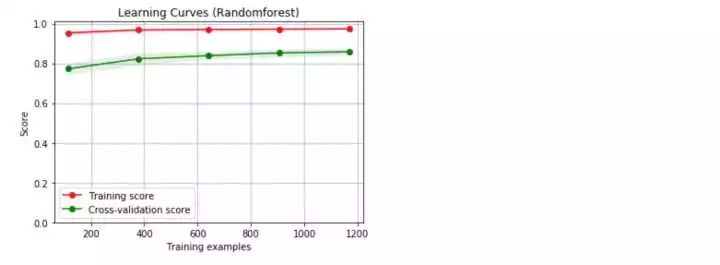
我們采用的是默認的參數,沒有調優處理,得到的兩個基準模型都存在過擬合現象。下面,我們開始著手參數的調整,希望能夠改善模型的過擬合現象。
6、參數調優
嶺回歸正則項縮放系數alpha調整
- alphas =[0.01,0.1,1,10,20,50,100,300]
- test_scores = []
- for alp in alphas:
- clf = linear_model.Ridge(alp)
- test_score = -cross_val_score(clf,X,y,cv=10,scoring='neg_mean_squared_error')
- test_scores.append(np.mean(test_score))
- import matplotlib.pyplot as plt
- %matplotlib inline
- plt.plot(alphas,test_scores)
- plt.title('alpha vs test_score')

alpha在10-20附近均方誤差最小
隨機森林參數調優
隨機森林算法,本篇中主要調整三個參數:maxfeatures,maxdepth,n_estimators
- #隨機森林的深度參數
- max_depth=[2,4,6,8,10]
- test_scores_depth = []
- for depth in max_depth:
- clf = RandomForestRegressor(max_depth=depth)
- test_score_depth = -cross_val_score(clf,X,y,cv=10,scoring='neg_mean_squared_error')
- test_scores_depth.append(np.mean(test_score_depth))
- #隨機森林的特征個數參數
- max_features =[.1, .3, .5, .7, .9, .99]
- test_scores_feature = []
- for feature in max_features:
- clf = RandomForestRegressor(max_features=feature)
- test_score_feature = -cross_val_score(clf,X,y,cv=10,scoring='neg_mean_squared_error')
- test_scores_feature.append(np.mean(test_score_feature))
- #隨機森林的估計器個位數參數
- n_estimators =[10,50,100,200,500]
- test_scores_n = []
- for n in n_estimators:
- clf = RandomForestRegressor(n_estimators=n)
- test_score_n = -cross_val_score(clf,X,y,cv=10,scoring='neg_mean_squared_error')
- test_scores_n.append(np.mean(test_score_n))

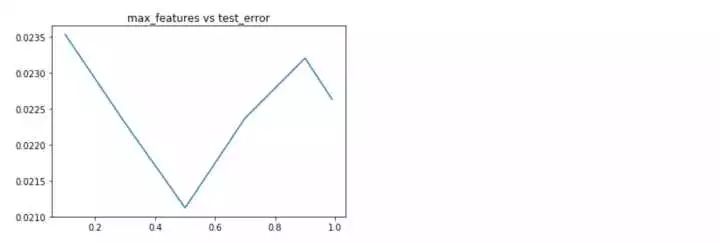

隨機森林的各項參數來看,深度位于8,選擇特征個數比例為0.5,估計器個數為500時,效果***。下面分別利用上述得到的***參數分別重新訓練,看一下學習曲線,過擬合現象是否得到緩解?
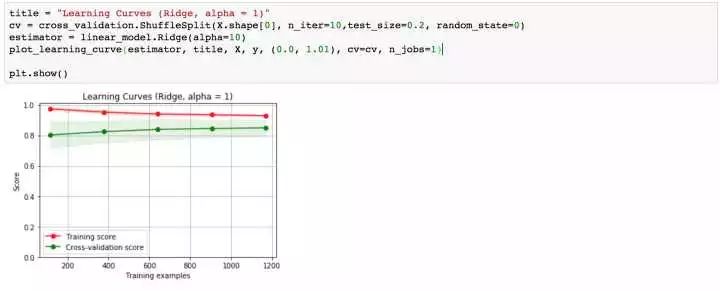
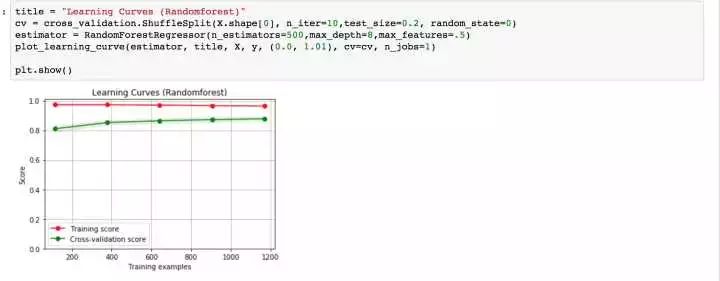
再回想一下,我們最初的基線模型學習曲線的形狀,是不是得到了一定程度的緩解?OK,下面我們采用模型融合技術,對數據進行預測。
- #預測
- ridge = linear_model.Ridge(alpha=10).fit(X,y)
- rf = RandomForestRegressor(n_estimators=500,max_depth=8,max_features=.5).fit(X,y)
- y_ridge = np.expm1(ridge.predict(test_df.values))
- y_rf = np.expm1(rf.predict(test_df.values))
- y_final = (y_ridge + y_rf)/2

本篇房價預測的模型搭建已經完成。同樣,再梳理一邊思路:
一、本篇用到的房價數據集存在比較多的數據缺失,且分類變量十分多。在預處理階段需要將訓練集和測試集合并,進行缺失填充和one-hot獨熱變量處理,保證數據處理過程的一致性,在數據缺失填充過程中,需要綜合考慮特征的實際描述和數據的分布,選擇合適的填充方式填充;
二、為防止數據變量不統一帶來的模型準確率下降,將數值型特征進行標準化處理,數據處理完成后,按照數據合并的方式,再還原到訓練集和測試集;
三、先構建嶺回歸和隨機森林基準模型,進行三折交叉驗證,繪制學習曲線,存在明顯的過擬合現象;
四、接下來分別對兩個基準模型進行參數調優,獲得使得均方誤差最小的參數,返回到訓練集進行訓練;
五、采用并行模型融合的方式,計算兩個模型預測結果的均值作為測試集的預測結果。






























